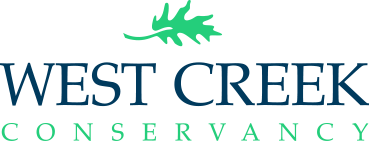Project Summary
Our vision took a significant leap forward in 2022 with the addition of a 1.5 acre growing enclosure, a large hoop house, and a staging enclosure. With the necessary infrastructure in place to protect nursery stock from wildlife pressure, the exciting part began—propagation! Currently there are over 800 native trees installed in the growing exclosure, with more to come. Keystone species, such as oak, willow, and cherry, are strongly represented and other valuable native species are in the queue to diversify inventory.

Project Partners
Stearns Native Nursery is managed by West Creek Conservancy in partnership with the City of Parma and supported by Cuyahoga County and the Cuyahoga Soil & Water Conservation District.
We are working with Parma’s 4-H club, the Homestead Hoofers, on the removal of the invasive phragmites from the property which in turn will increase biodiversity and habitat for native species.
Cuyahoga Soil & Water Conservation District is studying the effects of mycorrhizal fungi on soil structure and root health in urban soils in our growing enclosure.
We are also supporting The Holden Arboretum as they create a local ecotype seed bank intended to reforest the lower Great Lakes region.
Outcomes and Benefits
Stearns Native Nursery is also place of study, education, and engagement. It is part of a larger conservation-restoration initiative poised to facilitate growing awareness around the importance of restoring and conserving our planet for future generations.
Given time and proper care, our trees will mature before being planted in local communities to restore the urban tree canopy, resulting in cleaner air, stormwater control, and cooler summer temperatures.
While the saplings mature in the growing enclosure, native wildflower propagation is ramping up in the new hoop house. Our hoop house is filled with plants that support native bird and pollinator populations.
People have begun to appreciate the importance of rebuilding native ecosystems and realize that yards can be a source of this environmental change. Not only are native gardens appealing from a time, resource, and energy use standpoint, they also support a healthy and diverse ecosystem better able to withstand the effects of a changing climate.
FAQs
What is West Creek Conservancy's Native Plant and Seed Collection Program?
West Creek Conservancy’s restoration projects are finished with a beautiful assemblage of native trees and wildflowers. As a best practice, we strive to use local ecotype plants in our restorations. In a few words, local ecotypes are native plant species that have a genetic background typical for the local region. Planting with locally sourced plants has several very practical consequences–not only do local ecotypes thrive in regional soil and climate conditions, they also:
- are more resistant to local herbivores (yes, deer included!)
- are better resources for local pollinators and birds
- maintain the desirable genetic characteristics of the local wild plant populations
West Creek Conservancy responsibly collects native nuts, seeds, seedlings, and cuttings to propagate at Stearns Native Nursery. You can help us with our Native Plant and Seed Collection if you have native tree or shrub seedlings to donate or if you would like to collect the following nuts. Please find details on donating seedlings and/or collecting nuts in a separate resource: Harvesting Guide for Native Seedlings and Plants
- Hickories: Bitternut, Shagbark, Pignut, Mockernut, or Shellbark
- Black Walnut
- Ohio Buckeye
*Note: It is illegal to collect from the National Parks or Metropark locations. Please ask permission from homeowners if you are not collecting on your own property.
I have seedlings/saplings to donate. How can I do that?
Stearns is always in need of native trees and seedlings. To get your native plants to the Stearns Nursery, follow this harvesting guide in our resources library.
Contact Kara Benninghofen to coordinate the drop-off of plant material. She can be reached at (216) 749-3720 x11 or kara@westcreek.org.
How can I contribute to the Native Seed Collection Program?
You may contribute to the Navie Seed Collection Program by following these steps:
- Determine if the seeds are ready to harvest. Read about how to know when native seedlings are ready to be harvested in our resources library.
- Take pictures of the tree, leaves, bark, and seeds.
- Place seeds in brown paper bags to prevent molding. Write the address and date of the harvest on the bag.
- Contact Kara Benninghofen to coordinate the drop-off of plant material. She can be reached at (216) 749-3720 x11 or kara@westcreek.org.
*Note: It is illegal to collect seeds in the Metroparks or National Parks. Please look for these species in your neighborhood parks, cemeteries, and backyards! Always get permission from the homeowner if the tree is not on your property.
Do you sell the plants and trees you're growing?
We do not sell what we grow to the public. The supply of local ecotype plants has not yet caught up with the demand. Our inventory supports West Creek’s local conservation and restoration initiatives. The plants are given time and proper care to mature before being planted in local communities.
Our Gallery



Donate Now
Our Wish List
Amazon’s Wish Lists lets charities receive online donations straight to their doorstep. Click the link below to discover how you can help the Tree Nursery.
